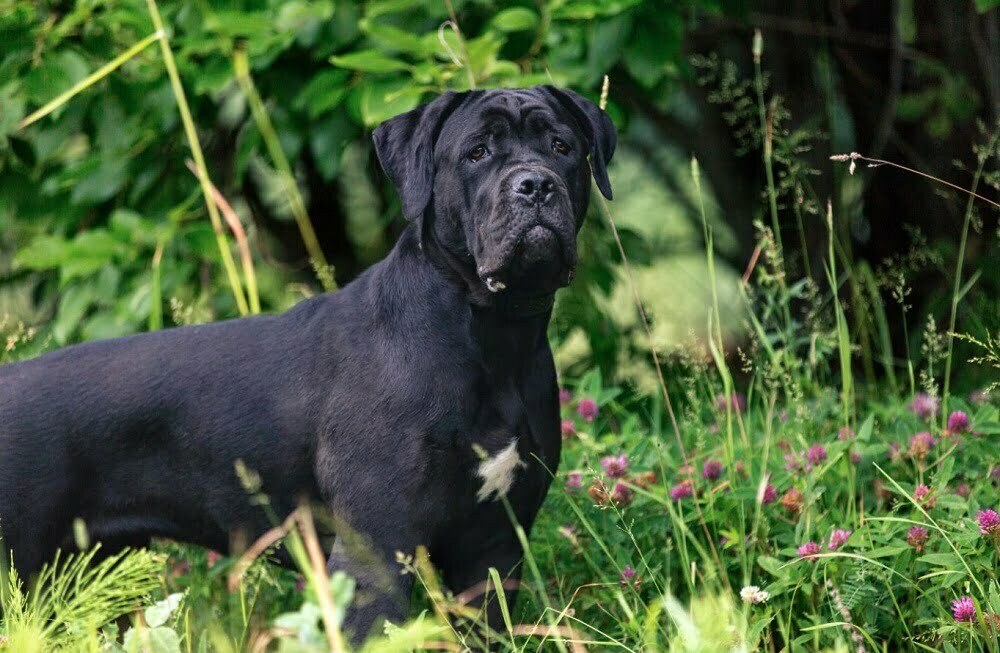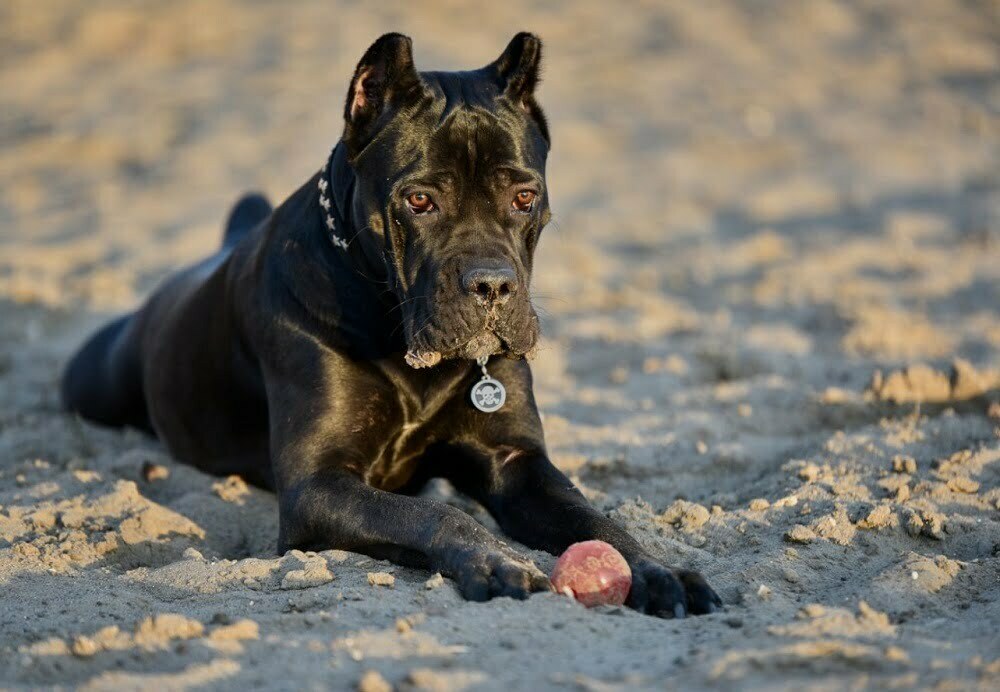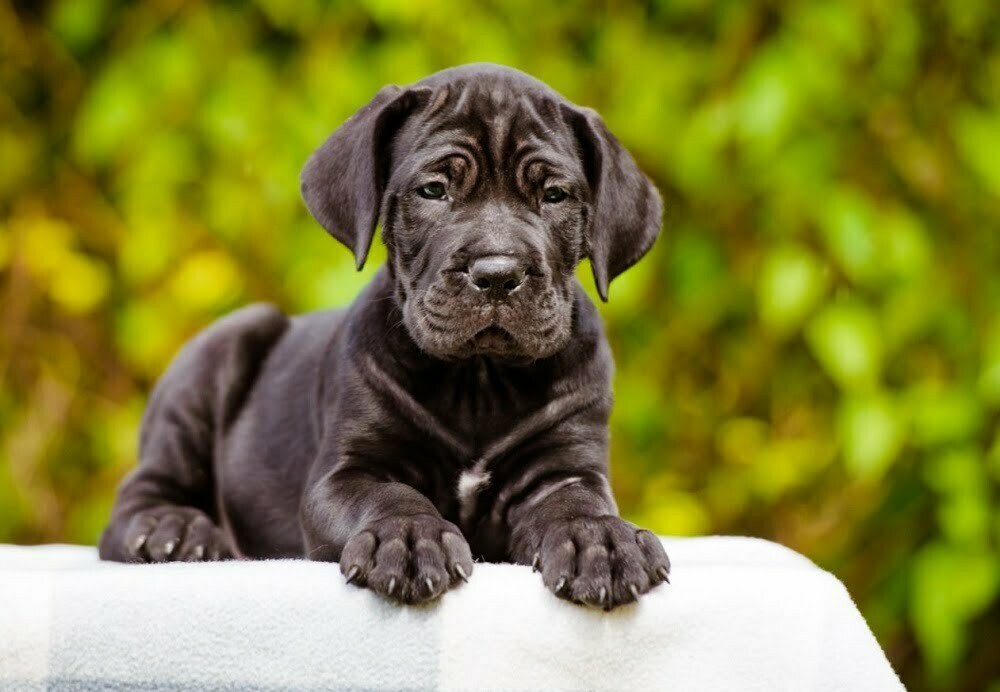If you’ve ever seen a Cane Corso, especially in person, it’s understandable that you may have felt intimidated by this dog’s giant size.
The Cane Corso commands attention and respect with its large, muscular build and has been employed as a hunting and guard dog for centuries.
However, these days, more and more people are bringing these working dogs into their homes as companion animals. Their loyalty, even temperament, and trainable nature make Cane Corsos excellent family dogs.

With that being said, the Cane Corso has some pretty high-maintenance care requirements. So, before you commit to integrating this Mastiff breed into your family, you should do your due diligence and make sure that you will be the right fit.
Luckily, we’ve done all the research into this breed so you don’t have to! Keep reading to find out all about Cane Corso’s history, temperament, trainability, and grooming needs, and more crucial information.
Key Facts
Average Lifespan
The average lifespan of the Cane Corso is between 10 and 12 years. However, it should be noted that this estimate only applies to Cane Corso dogs that are within a healthy weight range and don’t have any other existing health conditions.
Minimum Exercise (Per Day)
The Cane Corso is a giant dog with a giant energy supply. This means your Cane Corso will need at least 2 hours of exercise daily to stay happy and in good shape.
Most importantly, you should take your Cane Corso on 2 long walks every day, shifting the pace into a jog if both you and your dog feel comfortable doing so.
However, on-lead exercise is unlikely to be enough to satisfy a Cane Corso in the long term. It’s also a good idea to make time every day for your Cane Corso to run and play more freely. You will need to make sure that you have a safe, ideally fenced space for your dog to play in without the risk of surprise encounters or potential confrontations.
Because training is a big part of the average Cane Corso’s life, part of your Cane Corso’s daily exercise routine should take the form of training sessions.
Coat Length
The Cane Corso’s coat consists of a top coat and an undercoat, both of which are usually straight and short. However, the coat can begin to verge on medium-length if regular grooming is not undertaken.
Cane Corsos do not have particularly dense coats – they usually fall somewhere between light and regular on the spectrum.
Minimum Cost (Per Month)
If you’re planning on bringing home a Cane Corso, you will need to budget to spend at least $110 every month on expenses.
For more detail on the costs of owning a Cane Corso, see our ‘Costs’ section towards the end of this article.
Appearance
Size
Most of our readers will already be aware that the Cane Corso is considered a giant dog breed. But how large exactly is the average Cane Corso?
Average Height
Traditionally, measurements of Cane Corso dogs are taken at the withers, which is the area just between the shoulder blades.
Male Cane Corsos can measure up to 27.5 inches at the withers, while females stand slightly smaller at 26 inches.
Average Weight
The average weight for a male Cane Corso is between 45 and 50 kilograms. In pounds, that’s from 99 to 100 pounds!
The average female Cane Corso is a little lighter, at 88 to 99 pounds.
Temperament

Apartment Living
Cane Corsos do not adapt well to apartment living. Not only are they physically so large that smaller apartments would likely feel claustrophobic for them, but they’re so high-energy that apartment living would cause this breed to feel bored, restless, and unhappy.
If you’re looking for a dog to live with you in an apartment situation, we would strongly recommend choosing a different, ideally smaller breed with fewer exercise needs.
Good for Novice Owners?
We wouldn’t recommend a Cane Corso as a first dog for new dog owners. Cane Corsos demand a lot of their owners’ time and energy, requiring at least 2 hours of exercise a day. This may be too big of an adjustment for first-time owners.
Moreover, the Cane Corso needs a lot of training from a competent and experienced owner to ensure that its naturally headstrong temperament doesn’t get out of control. That’s not to say that Cane Corsos are inherently disobedient or difficult dogs, but poor guidance from their owners can be detrimental to their temperaments.
Sensitivity Level
The Cane Corso is a moderately sensitive dog breed. While it isn’t skittish or anxious by nature, the breed has developed to be very territorial and tuned in to the smallest signs of danger due to its history as a guard dog.
Cane Corso will pick up on the minor signs of aggression, distress, threat, and fear. That’s why raising a Cane Corso in a calm and stable environment is important.
Tolerates Being Alone?
If you’re somebody with a lot of existing time commitments that force you to be out of the home for long periods of time, a Cane Corso may not be the best choice of dog for you.
Cane Corsos form strong bonds with their owners and can become very anxious when separated from them. Plus, being away from your Cane Corso for extended periods may mean that you aren’t able to provide them with the exercise they need, which would be detrimental to their health and happiness.
Tolerates Cold Weather?
Cane Corsos don’t have the longest or thickest coats, so they’re not built to spend hours on end in extremely cold temperatures.
With that being said, these large dogs have a lot of muscle mass, which can help to keep them protected against the cold in the short term.
Tolerates Hot Weather?
The Cane Corso breed is better adapted to tolerate hot weather than cold weather. Their short coats mean that they won’t overheat as easily as some other breeds.
However, extreme heat should be avoided in the same way that you should try not to leave your Cane Corso exposed to extreme cold for too long.
Affectionate with Family?
Cane Corsos have historically been bred to work alongside humans in hunting, farming, or guard dog capacity. Therefore, they have adapted to form very strong bonds with their human families.
The Cane Corso has been known to be highly affectionate and, despite their size, very gentle with family members. Cane Corsos can develop separation anxiety, which means they may be extra affectionate towards you when you come home from work or running errands.
Kid-Friendly?
The Cane Corso can be a good choice of dog for families with older, sensible children. However, because they are so large and sensitive, they may not coexist well with younger children, particularly if they are excitable.
Dog-Friendly?
Cane Corsos do best with larger dogs of the opposite sex. Male Cane Corso can become defensive and aggressive with other male dogs, and because they have a natural prey drive, smaller dogs can trigger aggressive behavior in the breed.
Friendly Toward Strangers?
If Cane Corsos are socialized properly as puppies, they should learn to be tolerant of strangers, although they are unlikely to be overly enthusiastic about the presence of humans that they don’t know.
That said, if a Cane Corso perceives a stranger as a threat to their family, they may become aggressive.
Health and Grooming
Shedding
Although Cane Corsos have short coats, both their topcoats and undercoats shed mildly to moderately throughout the year.
The shedding season for the Cane Corso occurs in Spring and Fall, during which time these dogs are likely to shed more than during other months.
Drooling
The Cane Corso drools more than most smaller dogs because they have longer, drooping jowls. Because of this, they can often produce slobber when they’re hungry after drinking or when they’re excited or panting.
However, Cane Corsos don’t drool as much as other Mastiff breeds.
Grooming
Cane Corsos don’t need grooming as often as some other breeds because they only have short coats. Nevertheless, grooming a Cane Corso can be time-consuming because of how large the breed is.
You should brush your Cane Corso on a weekly basis using a natural bristle brush. Bathing can be played by ear and undertaken whenever the dog’s coat becomes soiled or every month.
Thanks to the active lifestyle of the average Cane Corso, you shouldn’t need to trim this dog’s nails very often because they get naturally worn down. However, we still recommend giving your Cane Corso’s nails a gentle trim at least once a month if you notice that they’re getting longer. Don’t cut them too short, though, since this can hurt your dog and damage the blood vessels in their nails, resulting in bleeding.
General Health
Generally speaking, the Cane Corso is quite a healthy breed that isn’t overly prone to developing health conditions.
However, some health problems have been observed in the breed, which we’ll discuss in more detail in our next section.
Common Health Problems
Cane Corsos often suffer from elbow and hip dysplasia, which is a misalignment in the joints in these body parts. If untreated, this can eventually lead to the more serious disease of arthritis.
Gastric Dilation Volvulus has also been observed in this breed. This is a condition where the stomach becomes twisted, a serious medical emergency requiring immediate attention.
Moreover, certain eye conditions, such as cherry eye, entropion, and ectropion, may be more common in Cane Corsos than in other breeds.
Potential for Weight Gain
Cane Corsos have big appetites and are built to get a lot of exercises every day. Therefore, if they’re not fed a healthy diet or aren’t exercised enough, they can quickly become overweight.
Trainability
Easy to Train?
As long as training is started when your Cane Corso is still a puppy, this dog breed is relatively easy to train.
The Cane Corso may be naturally headstrong, but because it bonds so closely with its humans, it is inclined to listen to commands. They love to receive praise from their owners, which is a great incentive to engage in training.
When they feel safe and are in the presence of their owner, Cane Corsos are usually calm and focused. This bodes well for successful training sessions.
Intelligence
The Cane Corso is a highly intelligent dog. They have excellent attention spans and long memories.
Because these dogs are so intelligent, you’ll need to play with them regularly and provide them with toys to keep them mentally stimulated. Otherwise, they are likely to get bored and frustrated, which can lead to destructive behavior.
Potential to Bite
Cane Corsos have a bit force of 700 psi, which is amongst the strongest bites of any dog breed. Therefore, it goes without saying that you definitely wouldn’t want to be on the receiving end of this breed’s powerful jaws.
However, with the correct training and socialization, the Cane Corso should quickly develop good bite inhibition and self-control.
In the U.S. and Canada, between the years 1982 and 2014, there were 21 reported Cane Corso attacks, 12 of which resulted in maimings. That’s roughly 1 attack every 1.5 years, and a maiming every 2.6 years.
Tendency to Bark or Howl
The Cane Corso does not bark excessively compared to many other breeds. However, its guard dog nature means that it will likely bark or howl at strangers as a warning.
History

The Cane Corso originates from Italy and is related to the Neapolitan Mastiff. It is thought that the Cane Corso is directly descended from the Roman War Dog.
Cane Corsos were initially bred for the purpose of being working dogs. Their duties included hunting as well as shepherding animals on farms.
While it’s not entirely clear when the Cane Corso was bred into existence, artwork has been observed as early as 700 BC showing a very similar-looking dog involved in hunting.
With the industrialization and mechanization of farming and the decline of hunting as a sport and a means of providing food, the Cane Corso decreased in popularity as a breed. However, in the 1970s, societies were set up dedicated to the breed, and in 1996, the Cane Corso was officially recognized.
The history of Cane Corso’s name is another interesting subject to touch on because even linguistic experts are not 100% sure about its etymology.
Many of our readers will already know that the word ‘Cane’ is Latin and translates to ‘dog’ in English. However, ‘Corso’ could have 2 possible meanings. Some experts believe that ‘Corso’ comes from ‘Corsus’, which is Old Italian for ‘robust’. Meanwhile, others have theorized that the latter half of this breed’s name may be linked to another Old Italian word, ‘Cohors’, which means ‘bodyguard’.
Costs
We would always encourage our readers to rehome Cane Corso dogs from shelters or rescue centers rather than buying them from breeders. The cost of adopting a Cane Corso is much lower than buying, at roughly $350 to $550.
However, if you do choose to buy a Cane Corso from a breeder, you can expect to pay between $900 and $3,000. On average, buying a Cane Corso puppy costs $1,400.
Some breeders pride themselves on breeding dogs with award-winning lineages, in which case, you could find yourself paying as much as $8,500.
But the initial cost of purchasing a Cane Corso is far from the only cost involved in looking after this dog.
The Cane Corso is a big breed with an equally big appetite. This means that you’ll be spending a lot of money on food. You can expect to spend $1000 on food for your Cane Corso every year if, as we recommend, you purchase high-quality food.
On top of that, there will be veterinary costs, including the cost of vaccinations. If you adopt, you will probably have vaccinations included with your adoption fee. On average, a single vaccine costs $87.50.
In the worst-case scenario that your Cane Corso develops Gastric Dilatation Volvulus, you might need to pay up to $7,500 for surgery and other treatments. However, even regular checkups can add up to several hundred dollars each year.
Obedience training can cost anywhere between $30 and $120 per class. Discounted prices may be available if you sign up for an obedience training course, which typically lasts for at least 4 weeks.
Fun Facts
- The Cane Corso can run at an impressive speed of 32 miles per hour.
- Cane Corsos come in a wide range of colors, including black, gray, chocolate, chestnut, red, fawn, blue, straw, isabella, grey brindle, and black brindle.
- The Cane Corso is thought to have the 3rd strongest dog bite in the world, at a force of 700 psi. That’s stronger than the bite of a pitbull, and it’s only beaten by the Kangal and Bandog.
